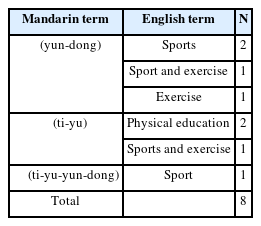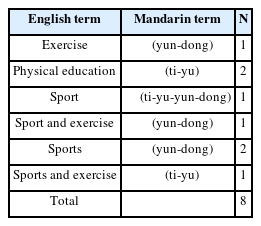Reconsidering the Hierarchy and Translation of “Physical Education/Sports” Related Terms: Taiwan Perspective
Article information
Abstract
OBJECTIVES
In the past centuries, the concept of “physical education” has changed from a more general concepts including physical activities and sports, to specifically inferring “instruction of physical activity”. Instead, “sports” has become the comprehensive concept of sports, exercise, and physical education. Given to the inconsistent terminologies and English translations of “體育 (ti-yu)” (physical education) and “運 動 (yun-dong)” (sports or exercise) in Mandarin, the purpose of this study was to investigate in the current terminology usage, hierarchy, and the English translation of “體育 (ti-yu)” and “運動 (yun-dong)” in Taiwan.
METHODS
Three government authorities, two sport related universities, eight top sport and exercise journals, and nighty-six college departments in Taiwan were analyzed.
RESULTS
“運動 (yun-dong)” was the most widely used terminology as “體育 (ti-yu)” occupied the majority usage among government authorities, sport related universities, and title of top sport and exercise journals. Regarding English translation, despite of “department of physical education”, “sports” remained the most common terminology. Moreover, “體育 (ti-yu)” and “sports” are the highest hierarchy among government authorities, and sport related university; “體育 (ti-yu)” and “physical education” are the highest hierarchy among traditional sport and exercise journals; “運動 (yun-dong)” and “sports” are the highest hierarchy among college departments also the mainstream of current translation and hierarchy.
CONCLUSIONS
“體育 (ti-yu)” was the highest hierarchy in the past. However, “運動 (yun-dong)” has been the mainstream of the highest hierarchy in Mandarin according to college departments. In English, “sport(s)” is the main term in Taiwan when translating “體育 (ti-yu)” and 運動 (yun-dong)”, also being the highest hierarchy. On the other hand, “體育 (ti-yu)” and “physical education” are utilized regarding those departments focusing on educating PE teachers. This study expects the terminology, English translations, and hierarchy being align with the mainstream of current translation and hierarchy in the future.
前言
體育 (ti-yu) 與運動 (yun-dong) 在當今臺灣社會蔚為流行, 尤其在2017台北世大運的承辦, 2020東京奧運優異表現後, 社會大眾對於運動, 運動賽會的關注度皆有明顯提升;另亦隨著政府投入與挹助, 國民自身在運動參與也日益增加 [1]. 回首百年歷史, 體育的發展經歷了三個階段的變革 [2]:第一階段為19世紀後期, 從健康養生至體操, 並作為身體訓練重要內容;第二階段為20世紀初期, 朝向自然與新體育, 擺脫機械化體操, 在運動中保持自然, 有創意和流暢的動作. 雖然在此時對於體育的定義各有立場和想法, 不過仍有一些共同的看法;第三階段則為體育的認同與學術化間的爭辯, 當時認為「體育」一詞的學術含意薄弱, 應以更精確的用語來表達身體活動的學術體系 [2]. 上述各階段對於體育一詞之後續產生在新觀念形成與轉變的極大影響. 需要注意的是, 體育一詞在現今所表達之概念仍有所歧異, 該名詞有時指位階最高之總稱位,有時為學科名稱, 有時甚至指教學內容.
體育採用“physical education”作為翻譯已超過百年歷史 [2,3], 然而, 美國學者Staley於1930年代提出該用語的不適當性, 主張應以“sport”來替代“physical education”, 後因現實問題, 最終未被採納 [2]. 1964年美國學者Henry於〈體育的學術性〉中將體育做出如下定義:「體育漸漸地成為一門正式的學科, 匯集了身體生理學和運動科學的知識, 此內容具涵價值」. 然而, 1960年代, 美國十大聯盟會議 (Big Ten Conference) 則試著以「運動研究 (sport studies)」建構其新學科與次領域, 進而取代「體育」一詞 [4]. 在此期間, 西德也將「體育」一詞改為「運動」, 並將常以實驗導向的「體育理論」改為「運動科學」;另自1970年代起, 許多體育一詞之名稱也依序更改, 如:「體育理論」改為「運動科學」;「體育教師聯盟」更改為「運動教師聯盟」;期刊中的「體育」也改為「運動教學」;此時也由教育部公布了「體育科」教學指南.
1988年代, 美國人體運動學學會 (American Kinesiology Association, AKA) 建議以「人體運動學 (kinesiology)」 一詞來取代體育 [5]. 該學會認為, 人體運動學主要為推動和促進人體動作和身體活動的藝術與科學研究和教育應用, 其身體活動包含:體適能, 動作技能學習, 日常生活中的活動, 舞蹈或遊戲…等, 且對象方面包含而不僅限於兒童, 成人, 年長者, 受傷者和競技運動員. 美國體育運動之重要學術組織, 國家人體運動學院 (National Academy of Kinesiology, NAK) 更將人體運動學範圍拓廣, 並定義其為「人體運動學 」系指對動作的研究 (study of movement), 在美國高等教育中, 這個術語用來描述一個多面向的學術領域, 其中動作或身體活動 (physical activity) 是知識的焦點. 身體活動包括為改善健康和體適能而運動;學習動作技能;以及參與日常生活, 工作, 運動 (sport), 舞蹈和遊戲等活動. 它涵蓋了一般人口以及特殊群體, 如兒童和老年人;患有殘疾, 受傷或患病的人以及運動員 [6]. 為此, 美國大專校院的體育相關系所隨後陸續由體育系 (Department of Physical Education) 更名為人體運動學系 (Department of Kinesiology), 而體育教育學 (Physical Education Pedagogy) 或運動教育學 (Sport Pedagogy) 則劃分至為人體運動學的次領域, 主要以學校體育課程, 以及涉及體育專業領域的教學與教師培訓應用研究. 在學校體制下教授的運動並帶有教育目的之課程, 也多採用體育 (physical education) 作為翻譯. 此名詞上的分類不僅使人更淺顯易懂, 也讓傳統體育專業保有發展空間.
由上述回顧可以發現, 歐美國家的體育運動發展, 在過去的百年間已由 “physical education (體育)”為上位的概念, 逐漸轉變為當今較為位階較低之課程或教學的一部分, 而使用「運動」來代表涵蓋更大的上位概念. 另也發展出許多如「人體運動學」, 「運動科學」等次專業來區分「體育」. 然而是否採用「運動」一詞替代「體育」, 隨著社會變遷, 不同國家對於此仍有不同的解釋, 如:在西德學界看來, 從體操至遊戲都被視為「運動」(sport) 的下位概念. 另外日本學者則認為, 休閒, 休憩和各種以遊戲或競技態度進行運動活動的整體, 都被歸類為運動 (sport) [2]. 而在1975年「歐洲全民運動憲章」(European Sport for All Charter) 中, 對於運動 (sport) 的概念也有所定義, 如一, 競技性的團隊比賽;二, 戶外運動;三, 美的運動;四, 調整運動在內的四大主要身體運動領域, 皆納入運動 (sport) 之範疇 [7]. 總體來看, 社會和運動概念之間相互影響, 不論是運動概念的改變, 抑或是促使社會生活的變化, 從觀看競技比賽, 或者享受運動的汗流浹背, 室內或戶外, 有形或無形, 運動已經滲透成為每個人生活中的一部分, 同時也是社會文化的重要基石.
將視角回到當代臺灣, 「體育」與「運動」皆是廣為通用的說法, 如「體育電視臺」, 「體育表演會」, 「體育版」, 「運動項目」, 「運動新聞」, 「運動彩券」, 「運動賽會」, 然而「體育」與「運動」的概念是時常被混淆的, 更不用說其所屬之英文字“sport(s)”, “exercise”, “physical education”的翻譯多元繁複. 以教育部體育署為例, 英文名稱為Sports Administration, Ministry of Education, 使用「體育」, “sports”為上位階. 另細看體育署的單位職掌 (https://www.sa.gov.tw), 「全民體育」, 「競技運動」, 「學校體育」則翻為sports for all, competitive athletic, school physical education, 相同中文名詞然英文的位階則有多方改變. 另教育部體育運動大辭典 (https://sportspedia.perdc.ntnu.edu.tw) 對於體育運動領域有關的詞條, 映入眼簾的更是繁雜;例如「體育學原理」 之英文即有“the principle of physical education”與“the principle of kinesiology”兩個詞條. 「體育運動史」的英文是“sports history”;「臺灣體育運動史學會」的英文卻是“Taiwanese History of Physical Education and Sports Federation”, 而這些位階與翻譯的異同也只是冰山一角.
鑒於臺灣對於體育, 運動的使用名詞翻譯之多元化, 本文之目的在統整2023年現階段臺灣在體育, 運動與其翻譯的使用情況, 嘗試提供體育, 運動在位階上的使用現況, 以及其中英文名詞之使用, 以提供政府單位, 學術研究單位, 以及社會大眾, 乃至於華語使用「體育」, 「運動」之位階與及其翻譯的建議參考.
硏究方法
為調查現階段臺灣在體育, 運動相關之翻譯現況, 本文採取了四個方向進行統整與分析, 包含國家機構, 國內體育運動專業大學校名, 國內優質學術期刊名, 以及大專技職院校科系名稱等四類名稱. 以下說明之:
國家機構
在國家機構面向選擇掌管臺灣體育運動事務的最高行政單位「教育部體育署」;集結國內頂尖選手的「國家運動訓練中心」;和負責大專院校間體育運動事務的 「中華民國大專院校體育總會」做為分析.
國內體育運動專業大學校名
在國內體育運動專業大學校名面向, 選擇在臺灣直接以「體育」, 「運動」作為命名之體育專業大學, 計有兩間, 分別為「國立體育大學」, 以及「國立臺灣體育運動大學」.
國內優質學術期刊名稱
在國內優質學術期刊名稱面向, 依據臺灣社會科學引文索引資料庫Taiwan Social Science Citation Index (TSSCI) [8], 教育學門中體育學收錄的期刊做為依據, 並以TSSCI 第一級, 第二級之期刊作為資料分析.
大專技職院校科系名稱
在大專院校面向, 本次統整之資料庫係由「教育部111 學年度大專校院一覽表」(https://ulist.moe.gov.tw) 採集, 並以「體育」, 「運動」, 「競技」三個關鍵字進行搜尋, 其後再由各系所網站中查詢其使用之英文名稱.
資料分析
研究資料匯入Excel (Microsoft, USA) 後, 由研究者將各筆資料編碼為「體育」, 「運動」, 「競技」, 「運動競技」, 「競技運動」, 「體育運動」及「體育與運動」 何其對照之英文翻譯. 每筆資料僅屬於一種類別. 後續使用Excel中樞紐分析表之功能分析各類別資料之比例.
結果
國家機構
教育部體育署, 英文名稱為Sports Administration, Ministry of Education (https://www.sa.gov.tw/), 其中文使用「體育」, 英文使用“sports”作為翻譯. 國家運動訓練中心」, 又名「國訓中心」, 英文名稱為National Sport Training Center (https://www.nstc.org.tw), 其中文使用「運動」, 英文使用“sport”作為翻譯. 中華民國大專院校體育總會, 又稱「大專體總」, 英文名稱為Chinese Taipei University Sports Federation (https://www.ctusf.org.tw), 其中文使用「體育」, 使用“sports”作為翻譯.
國內體育運動專業大學校名
在體育運動專業大學的部分, 國立體育大學的英文翻譯為 National Taiwan Sport University (https://www.ntsu.edu.tw), 其中文使用「體育」, 英文使用“sport”作為翻譯;而國立臺灣體育運動大學的英文翻譯為National Taiwan University of Sport (https://www.ntus.edu.tw), 其中文使用「體育運動」, 英文使用“sport”作為翻譯.
國內優質學術期刊名稱
此次共有八本收錄在臺灣社會科學引文索引資料庫 (TSSCI) 中之體育運動相關期刊進行分析, 其中四本為第一級, 包括《體育學報》, 《中華體育季刊》, 《大專體育季刊》, 《臺灣運動心理學報》, 以及四本為第二級, 包括:《華人運動生物力學期刊》, 《運動生理暨體能學報》, 《運動表現期刊》, 《臺灣體育運動管理學報》. 表一將該些期刊之發行所屬單位進行中英文名稱之呈現 <Table 1>.

Title, publishers, and translation of top sport and exercise journals in Taiwan Social Science Citation Index (TSSCI).
結果發現, 名稱使用「運動」共4本, 使用「體育」的有 3本, 僅有一本使用「體育運動」. 英文名稱的部分, 各2 本使用“sports”和“physical education”. 另外, “sport and exercise”, “sports and exercise”, “exercise”和 “sport”各為一本 <Table 2 & Table 3>.
大專技職院校科系名稱
由「教育部111學年度大專校院一覽表」中搜尋「體育」, 「運動」, 「競技」三個關鍵字, 共有108個結果. 扣除重複納入, 及排除一所私校退場的校系之後, 總共有96個大專技職的科系, 學程, 碩士班納入分析. 中文系所名稱由「運動」, 「體育」, 「競技」, 「運動競技」, 「競技運動」, 「體育運動」, 以及「體育與運動」進行分類, 一個校系只屬於一種分類. 英文系 名則以“sport”, “sports”, “physical education”, “exercise”, “athletic”, “athletics”, “athletic sports”, “kinesiology”, “physical education & sport”, “physical education & kinesiology” 和“martial arts”進行分類, 一個校系亦只屬於一種分類.
結果顯示, 以中文名稱而言, 共有70個系所使用「運動」, 其比例最高 (73%);次之為「體育」, 共有16個系所使用 (17%);「競技」, 「競技運動」, 「運動競技」合計7所 (7%) <Table 4>.
英文名稱部分, 以“sport”和“sports”佔多數, 計有31所校系使用 (31%), 合計共三分之二 (~66%) 使用sport(s). “physical education”有14個校系次之 (15%);6所校系使用“exercise” (6%), 其次為“athletic” (4%) 和 “kinesiology” (3%) <Table 5>.
討論
國家機構與國內體育運動專業大學名:以體育與sport為上位階
在國家機構層級, 「體育」的使用佔多數 (體育署, 大專體總), 而國訓中心使用「運動」, 然而無論是教育部體育署, 國訓中心, 或是大專體總, 他們的英文翻譯皆是使用“sport(s)”來分別代表「體育」或「運動」. 可以看出 “sport(s)”是涵蓋範圍更廣大的概念, 然而中文的名稱卻存在分歧.
臺灣現有之兩所體育運動專業大學之中文名稱也有所差異, 國立體育大學使用「體育」, 臺灣體育運動大學使用「體育運動」, 而他們的英文翻譯都使用“sport”. 再次顯示“sport”在中文名稱上的不同. 由此也可發現, 國家機構與國內體育運動專業大學, 多「體育」代表涵蓋較大的上位概念, 而在英文使用“sport”為上位.
國內優質學術期刊之名稱:以體育與physical education/sports為上位階
在國內體育運動專業學術期刊方面, 《體育學報》, 《中華體育季刊》的英文名稱皆使用“physical education”, 可以看出這兩本期刊使用「體育」為上位概念, 英文以位階較低之“physical education”作為翻譯, 亦即該兩份期刊皆是以收入體育運動領域範圍較大的綜合性期刊, 較類似於英文“sport”之使用.
另一方面, 《大專體育季刊》的英文是“Sports & Exercise Research”, 以其所納含的專業面向較廣的現況, 該英文較為適當;有趣的是該名稱未包含「大專」 與「體育」, 中英文較為不相符. 值得一提的, 《大專體育季刊》是大專體總發行的期刊, 然而大專體總中的「體育」使用“sports”為翻譯;《大專體育季刊》中的「體育」卻是使用“sports & exercise”. 其餘期刊則皆採用通俗, 廣為被使用的翻譯, 如「運動生理學」為 “exercise physiology”, 「運動生物力學」為“sports biomechanics”, 「運動心理學」為“sport and exercise psychology”, 「運動管理學」為“sport management”和 「運動表現」為“sports performance”.
探究體育與運動在臺灣發展的歷史, 此研究推敲國家機構及體育運動專業大學在中文皆以「體育」為上位的原因. 「體育」一詞最早在明治維新時期, 藉由翻譯日本書籍進入臺灣社會, 而該時期的「體育」涵蓋了各式運動的總稱 [9], 為「體育」上位概念. 亦可從徐元民 (2006) 所著之《體育學導論》中發現其「體育」為上位的觀點. 徐元民 (2006) 稱『體育一詞 (physical education), 其實是個概括性用語屬於上位概念, 只是個總稱』 [10]. 由此可知, 在過去臺灣社會中, 「體育」上位是主流的概念, 因此不難理解「體育署」及「體育大學」的命名脈絡.
大專技職院校科系名稱:以運動與sports為上位階
不同於上述中文以「體育」為為上位階, 然所納含之意義較為廣大, 使得英文翻譯面向多元的現象, 在大專技職院校科系名稱分析後發現, 體育運動相關科系, 以「運動」為系所名稱佔大宗, 共70所超過七成, 其中不乏運動科學系, 運動醫學系, 及眾多以運動休閒命名的科系.
其次的以「體育」為命名的科系, 雖然僅16所 (17%), 但其中10所都是國內知名的體育系, 除孕育國手外並多以培育體育師資之學系, 如文化大學體育系, 輔仁大學體育系, 國立高雄師範大學體育系, 國立臺北教育大學體育系等. 亦即較為傳統之體育系所對於體育運動的概念, 仍使用相對侷限之「身體教育」, 而非更廣大的「運動」. 有趣的是, 亦有有部分傳統體育系所開始進行名稱轉換, 如國立臺灣師範大學, 國立清華大學和國立東華大學皆已在近年分別由「體育系」轉型為「體育與運動科學系」或「運動科學系」, 涵蓋更廣闊的運動科學概念.
在中英文對照的部分「運動」的英文翻譯即有多元化之繁複現況. 首先, 以“sport”跟“sports”約各佔四成, 其餘兩成為“exercise”, “kinesiology”, “athletic(s) ” 和“athletic sports”. 經過探究之後, 我們發現系所中文名稱有「健康」的, 在英文命名上多會使用“exercise”,如國立臺灣體育運動大學運動健康科學學系 (Department of Exercise Health Science), 臺北市立大學運動健康科學系 (Department of Exercise and Health Science), 文化大學運動與健康促進學系 (Department of Exercise and Health Promotion). “Kinesiology”是一個較新的概念, 中文應翻作「人體運動學」, 然而在臺灣使用“kinesiology”為名的科系, 中文系名多為「運動科學」或是「運動健康」, 如國立清華大學運動科學系 (Department of Kinesiology), 國立東華大學體育與運動科學系 (Department of physical education and kinesiology). 而“athletic(s) ”和“athletic sports”多為「運動競技學系」之英文翻譯, 如國立臺灣師範大學運動競技學系 (Department of Athletic Performance), 國立中正大學運動競技學系 (Department of Athletic Sports), 國立體育大學競技與教練科學研究所 (Graduate Institute of Athletics and Coaching Science). 另一方面, 「體育」則幾乎都翻譯為“physical education”, 較無異議.
除此之外, 研究結果還發現一些系所在翻譯上不容易直翻, 如培育眾多運動防護員的國立體育大學運動保健學系 (Department of Athletic Training), 由於運動防護在英文就是athletic training, 因此採用此英文系名似乎合理, 然而在中文系名上, 運動保健就無法詮釋“Athletic Training”的概念. 另有一些科系存在中英文不符的現象. 如臺北市立大學技擊學系 (Department of Martial Arts) 中的martial arts僅能代表武術, 沒有辦法完整包含「技擊」的概念, 宜參考中國文化大學技擊及國術學系採用 combat sports;國立體育大學體育推廣學系 (Department of Sport Promotion), 應採用「運動推廣」的名稱;國立成功大學體育健康與休閒研究所 (Institute of Physical Education, Health and Leisure Studies) 應以“exercise”或是“sport(s)”代替“physical education”以符合其「運動健康管理, 運動休閒管理, 運動科學產業」的系所架構主軸 [11].
綜合上述結果, 以中文而言, 「運動」仍是最廣泛被此用的詞彙;然而國家機構, 體育運動專業大學, 傳統期刊以及培育體育師資為主的科系, 都以「體育」為多. 以英文而言, “sport(s)”為較廣泛使用的名詞, 僅體育系皆翻譯為“physical education”. 此外, 國家機構及體育運動專業大學在中文皆以「體育」為上位, 而英文使用 “sport”為上位. 而在傳統期刊中文也以「體育」為上位, 然而英文卻使用位階較低之“physical education”為上位, 與西方國家習慣使用的“sport”為上位衝突. 在大專技職院校科系名稱中, 中文以「運動」為上位, 英文以“sport” 為上位, 是目前最主流的趨勢.
未來展望
雖然此研究發現英文採用“sport(s)”皆為主流, 然而中文名稱上卻存在「運動」, 「體育」及「體育運動」多種名稱, 且包含或許類似, 或許不同的構念及階層. 有鑒於許多時候「體育」與「運動」概念模糊, 或是存在中英不符的現象, 因此本研究提出一些建議及翻譯參考. 「體育」(physical education) 指的是「基於身體活動的教育」, 範圍較為聚焦於學校體制為主體. 而「運動」或「體育運動」(sports) 則能最廣泛的詮釋運動科學研究, 運動休閒, 運動產業等等面向. 「健身運動」(exercise) 是具有 「健康促進功能的身體活動」;「競技運動」(athletic sports) 是指「最高水準的體育運動」;「人體運動學」 (kinesiology) 則是「與人體運動有關的科學」. 「體育」 過去為上位概念;然而從大專技職院校科系名稱中發現, 「運動」為上位已成為主流. 同樣的, 以「運動」為上位的概念, 更能符合英文中以“sport”為上位的現況.
本研究也建議, 系所研究取向若包含「人因工程」, 「動作控制」, 「動作發展」, 而不僅限體育運動研究 [12], 可採用“kinesiology”為英文系名. 同時, 許多傳統老牌「體育系」, 也應重新思考其系所目標是單純培訓體育專業領域的教師, 還是更廣大的運動科學, 運動產業相關人才, 來達到名實相符. 同樣的概念, 國立體育大學, 臺灣體育運動大學, 稱之為「體育大學」, 也較局限於「身體教育」層面, 且與其英文校名有所不符, 建議臺灣兩所體育運動專業大學宜審慎思考其校名.
最後, 本研究發現當今「體育」, 「運動」之位階已與過去「體育」“sport”為上階有所不同, 然而國家機構與國內體育運動專業大學名更名程序繁瑣, 仍需多方考量;相比之下, 學術期刊及大專技職院校科系名稱, 已逐漸跟隨西方習慣使用之主流, 以「運動」“sport”為上位階. 然而, 此研究仍存在限制, 包括未討論「人體運動學」(kinesiology), 「身體活動」(physical activity), 運動 (exercise)之使用現況及位階, 期待未來的研究能涵蓋.
結語
透過搜集國家機構, 國內體育運動專業大學校名, 國內優質學術期刊名, 以及大專技職院校科系名稱來了解臺灣體育運動位階及翻譯之現況. 結果發現, 國家機構, 體育運動專業大學, 傳統學術期刊, 較常使用「體育」為名, 且以「體育」為上位概念;大專技職院校科系則主要使用「運動」為上位概念. 亦即「體育」過去為上位概念; 然而從大專技職院校科系名稱中發現, 「運動」為上位已成為主流. 在英文上, “sport(s)”是臺灣在翻譯「體育」, 「運動」時目前的主流, 且為上位概念. 若是以培育體育教學師資之系所, 則多以「體育」(physical education) 為名稱. 透過此研究結果, 希望臺灣在體育運動名詞的使用, 能符主流的位階概念, 也能讓華語使用圈, 能重新檢視 「體育」, 「運動」的概念及其英文翻譯, 以建立翻譯的一致性.
Acknowledgements
本研究獲教育部核定之國立臺灣師範大學「高等教育深耕計畫」經費補助, 以及教育部高等教育深耕計畫之特色領域研究中心經費補助, 由「國立臺灣師範大學學習科學跨國頂尖研究中心」與「國立臺灣師範大學社會情緒教育與發展研究中心」支應.
This work was financially supported by the National Taiwan Normal University (NTNU) within the framework of the Higher Education Sprout Project (HESP) by the Ministry of Education (MOE) in Taiwan, as well as "Institute for Research Excellence in Learning Sciences" and "Social Emotional Education and Development Center" of the Featured Areas Research Center Program within the framework of the HESP of the MOE in Taiwan.
Notes
The authors declare no conflict of interest.




